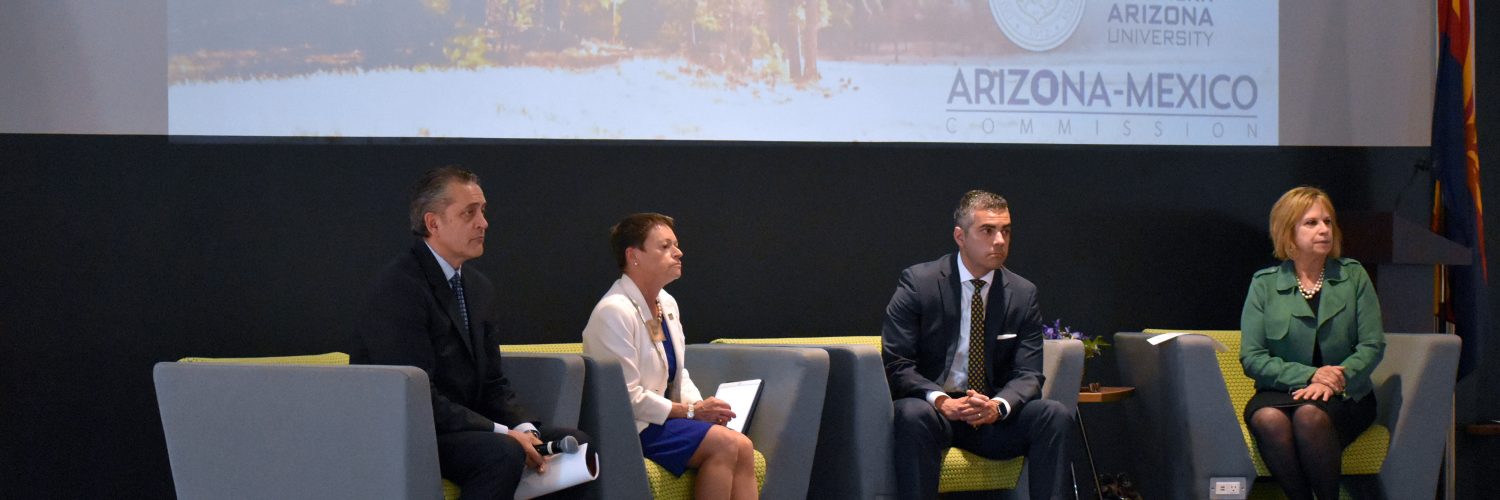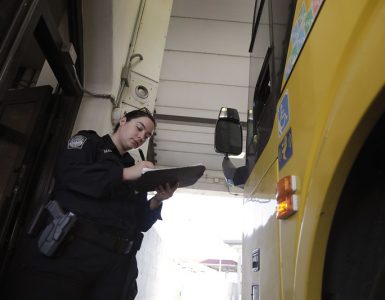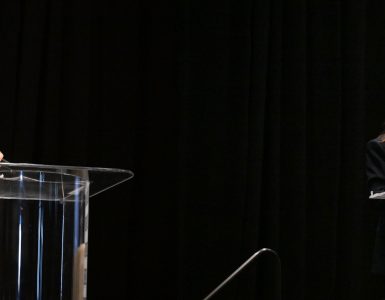The Arizona-Mexico Commission and the Greater Flagstaff Chamber of Commerce held a networking luncheon at Northern Arizona University’s Flagstaff campus last week to deliver an update on cross-border trade to business leaders from the northern part of the state.
“The relationship between Flagstaff and the AMC and NAU is not a new one,” said Juan Ciscomani, vice chair of the Arizona-Mexico Commission (AMC) and senior advisor for regional and international affairs at the Arizona governor’s office. “What is new is the elevated role that Flagstaff has now — a seat at the table of the Arizona-Mexico Commission.”
The AMC, which is celebrating its 60th year in 2019, has two new board members from Flagstaff: Julie Pastrick, president and CEO of the Flagstaff Chamber, and Daniel Palm, associate vice president for global initiatives and executive director of the Center for International Education at NAU.
“We’re so proud of these two appointments and the work that they do, and we want to continue to strengthen that relationship,” Ciscomani said. “Our friends down south love traveling to Arizona. We have everything to offer here in our state.”
Trade with Mexico as well as Canada extends beyond the border states, Ciscomani said. Cross-border tourism and commerce impact every state in the nation, and at least 30 states in the U.S. count Mexico or Canada as one of their top three trading partners, he said.
“As I travel with the governor and speak to other governors and their offices, the more I realize how unique the Arizona-Mexico Commission is,” Ciscomani said. “It has prospered, it has thrived for 60 years. We have a lot of heritage and legacy to celebrate.”
But the AMC will not be throwing an anniversary party and hanging up its spurs, so to speak. Instead, the organization must look ahead and prepare for the future, Ciscomani said.
“Just like there was no way to know what the first 60 were going to bring, there’s no way to tell what the next 60 will, either,” he said. “But one thing we have to do is make sure that Arizona is in the position… that we can continue to thrive through this relationship [with Mexico] — and not only thrive, but continue to lead.”
Arizona’s ports of entry along the U.S.-Mexico border make it well-poised to facilitate the majority of ground-based trade between the two nations. Just like cross-border trade extends to all 50 U.S. states, it extends well past Sonora, the Mexican state that borders Arizona directly to the south, into the heart of Mexico.
“The relationship that Juan talked about, for many years it was focused in Arizona and Sonora, and rightfully so — they’re our neighbors,” said Luis Ramirez, president of Ramirez Advisors Inter-National, at the AMC luncheon. “Our natural trade relationship with Mexico actually flows all the way through to Mexico City.”
Within the last decade, the Mexican government has invested heavily in the U.S.-Mexico trade corridor in order to foster the flow of commerce, tourism and trade between Mexico City and the border.
“The Mexican government and the last administration invested about $1.8 billion… in modernizing that entire corridor from Mexico City to the border in Nogales,” Ramirez said. “That includes bypasses around the major metropolitan areas along that highway, including Guadalajara, Tepic, Mazatlán, Culiacán, Ciudad Obregón and Hermosillo.”
Part of the modernization process included converting small highways topped with a thin layer of pavement to 30-centimeter-thick hydraulic concrete thoroughfares “equivalent to an I-10, I-17 and other high-speed connectors in the U.S.,” he said.
Investment along the corridor, which mostly follows federal Highway 15 in Mexico, is expected to save trucks at least four hours, but potentially 12 to 18 hours, in travel time between Mexico City and the border. This makes the corridor “more effective, more competitive and a better location decision for companies” that want to expand their business interests, Ramirez said.
The same way Arizona attracts businesses from California and other states, it is actively working to attract businesses from Mexico, too, Ciscomani said.
“It’s our job to make sure that Arizona remains open for business — low regulation, low tax — and also that we continue to promote this,” he said. “So much is based on the relationship and how Arizona is perceived in Mexico as well.”
Companies of all sizes and sectors can be part of the international relationship; Ramirez noted that Lucid Motors, a California-based luxury electric car manufacturer, chose to build its factory in Casa Grande, Arizona, in part to gain better access to the Mexican automotive industry.
Smaller Mexican businesses are making the move, too. Salsas Castillo, a popular salsa manufacturer from Mexico, recognized the potential of the U.S. Hispanic market and is considering investing $2 million in San Luis, a small city in southwestern Arizona, Ramirez said.
“For a community like San Luis with 32,000 people, a $2 million investment by a Mexican company is a substantial investment,” he said. “It might create 20 or 30 jobs, but those are well-paying jobs.”
Universities on both sides of the border are some of the biggest players in the Arizona-Mexico relationship.
NAU has a “brewing relationship” with several universities in Mexico and an increasing number of students from throughout Mexico studying on NAU’s Flagstaff campus, said president Dr. Rita Cheng.
The Flagstaff-based university, which has campuses across the state, has four partnerships in Sonora covering a range of disciplines including gastronomy, hotel and restaurant management, mechanical engineering, sustainable energy, biology and environmental science, Cheng said. The English as a Second Language (ESL) and Applied Linguistics doctorate programs at NAU are world-renowned, she said.
“NAU has always been known for our international strategies of deep partnerships with institutions in other countries, and we’re bringing that model to Mexico,” Cheng said. “We are really creating relationships that, I think, transcend borders.”
University faculty on both sides of the border act as ambassadors looking for internship opportunities for their students abroad, she said.
“A great example, not in Sonora but in the Baja, is our relationship with CETYS University and their business school,” Cheng said. “Our students have the opportunity to go to Mexicali, practice their Spanish, intern in businesses there and come back to Arizona.”
As the Arizona business community and state government continue to consider their relationship with Mexico, the AMC is “not taking our foot off the pedal,” Ciscomani said.
Instead, the organization will continue to foster partnerships with Mexican leaders, including Sonoran Gov. Claudia Pavlovich, to find common ground and move business forward.
“It’s all about finding common interests and having mutual respect for each other,” Ciscomani said. “If we can do those two things simultaneously, we can win, and that’s how Arizona has been winning.”
















Add comment